A) both goods, since they have an absolute advantage in both goods, and not trade.
B) only shoes, since they have a comparative advantage in the production of shoes, and not trade.
C) apples, since they have a comparative advantage in the production of apples, and not trade.
D) only apples, since they have a comparative advantage in the production of apples, and trade for shoes.
Correct Answer

verified
Correct Answer
verified
Multiple Choice
Suppose that a worker in Country A can make either 25 bananas or 5 tomatoes each year.Country A has 200 workers.Suppose a worker in Country B can make either 18 bananas or 6 tomatoes each year.Country B has 400 workers.The opportunity cost of one tomato in Country A is:
A) 100 bananas.
B) 20 bananas.
C) 5 bananas.
D) 4 bananas.
Correct Answer

verified
C
Correct Answer
verified
Multiple Choice
Suppose that a worker in Country A can make either 25 bananas or 5 tomatoes each year.Country A has 200 workers.Suppose a worker in Country B can make either 18 bananas or 6 tomatoes each year.Country B has 400 workers.The opportunity cost of one tomato in Country B is:
A) 108 bananas.
B) 18 bananas.
C) 6 bananas.
D) 3 bananas.
Correct Answer

verified
Correct Answer
verified
Multiple Choice
Suppose an American worker can make 20 pairs of shoes or grow 100 apples per day.On the other hand,a Canadian worker can produce 10 pairs of shoes or grow 20 apples per day.The opportunity cost for the United States is:
A) 5 apples for each pair of shoes.
B) 5 pairs of shoes for each apple.
C) 1/5 apple for each pair of shoes.
D) 1 pair of shoes for every 2 apples.
Correct Answer

verified
Correct Answer
verified
Multiple Choice
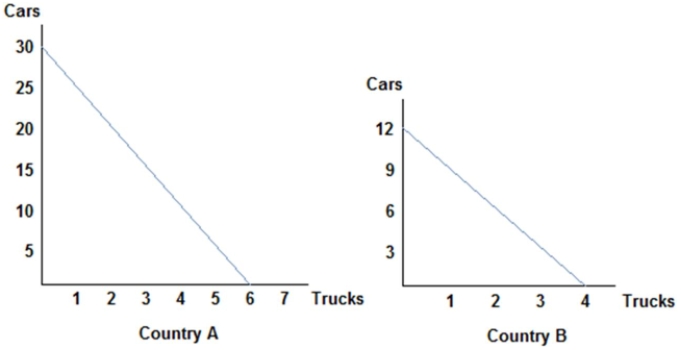 Refer to the figure shown,which represents the production possibilities frontiers for Countries A and B.Considering both country's production possibilities frontiers,we know that would both agree to terms of trade of one truck to:
Refer to the figure shown,which represents the production possibilities frontiers for Countries A and B.Considering both country's production possibilities frontiers,we know that would both agree to terms of trade of one truck to:
A) two cars.
B) four cars.
C) six cars.
D) eight cars.
Correct Answer

verified
B
Correct Answer
verified
Multiple Choice
Suppose that a worker in Country A can make either 10 iPods or 5 tablets each year.Country A has 100 workers.Suppose a worker in Country B can make either 2 iPods or 10 tablets each year.Country B has 200 workers.Country A would be using resources efficiently if it produced:
A) (500 iPods, 100 tablets) .
B) (500 iPods, 150 tablets) .
C) (500 iPods, 200 tablets) .
D) (500 iPods, 250 tablets) .
Correct Answer

verified
Correct Answer
verified
Multiple Choice
Consider the production possibilities frontier displayed in the figure shown.Which of the following combinations could not be produced?
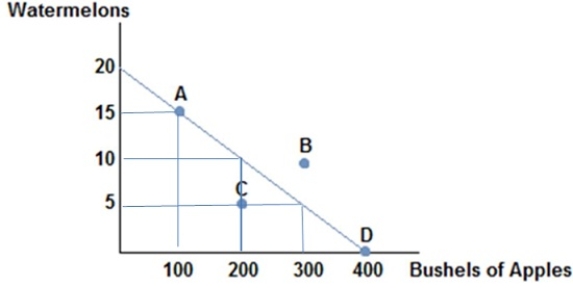
A) (20 watermelons, 400 bushels of apples)
B) (15 watermelons, 100 bushels of apples)
C) (10 watermelons, 150 bushels of apples)
D) (0 watermelons, 400 bushels of apples)
Correct Answer

verified
Correct Answer
verified
Multiple Choice
Suppose an American worker can make 50 pairs of gloves or grow 300 radishes per day.On the other hand,a Bangladeshi worker can produce 100 pairs of gloves or grow 200 radishes per day.Using the concepts of absolute and comparative advantage,we can say that the United States has the comparative advantage in:
A) the production of both gloves and radishes.
B) neither the production of gloves nor radishes.
C) the production of gloves only.
D) the production of radishes only.
Correct Answer

verified
Correct Answer
verified
Multiple Choice
When a producer has an absolute advantage at producing a good,it means the producer:
A) can produce more of that good than others with the same amount of resources.
B) has the ability to produce a good or service at a lower opportunity cost than others.
C) has no reason to trade with others.
D) is less efficient than other producers.
Correct Answer

verified
Correct Answer
verified
Multiple Choice
Tom and Jerry have two tasks to do all day: make dishes and build fences.If Tom spends all day making dishes,he will have make 16 dishes.If he instead devotes his day to building fences,Tom will build 4 fences.If Jerry spends his day making dishes,he will make 14 dishes; if he spends the day building fences,he will build 7 fences.Based on their production possibilities frontiers,Tom and Jerry:
A) can both benefit from trade because absolute advantage exists.
B) could both benefit from trade because comparative advantage exists.
C) cannot benefit from trade because Tom has the absolute advantage in both goods.
D) will not decide to trade because no comparative advantage exists.
Correct Answer

verified
B
Correct Answer
verified
Multiple Choice
Hurricane Katrina destroyed much of New Orleans and other parts of the South.Which of the following statements is true? The hurricane:
A) caused the production possibilities frontier of the United States to shift in.
B) caused the production possibilities to increase, since it created a lot of work to rebuild the city affected areas.
C) caused the production possibilities frontier of the United States to shift.
D) didn't change the production possibilities frontier, but moved from a point on the frontier to a point inside the frontier.
Correct Answer

verified
Correct Answer
verified
Multiple Choice
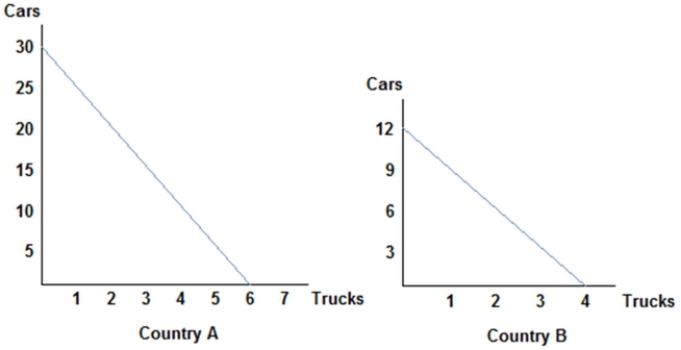 Refer to the figure shown,which represents the production possibilities frontiers for Countries A and B.One of the reasons why Country A and Country B are not realistic representations of actual countries is:
Refer to the figure shown,which represents the production possibilities frontiers for Countries A and B.One of the reasons why Country A and Country B are not realistic representations of actual countries is:
A) the production possibilities curves are straight lines; realistic ones would be concave.
B) they only represent the production of two goods.
C) they only represent two countries.
D) All of these statements are true.
Correct Answer

verified
Correct Answer
verified
Multiple Choice
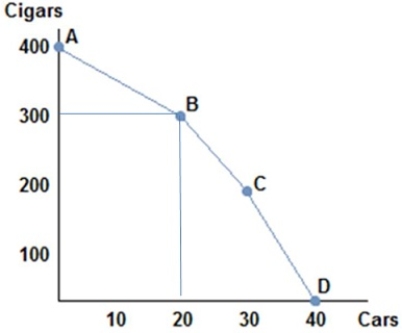 Consider the production possibilities frontier in the figure shown.As more and more cigars are produced the opportunity cost of producing more cigars:
Consider the production possibilities frontier in the figure shown.As more and more cigars are produced the opportunity cost of producing more cigars:
A) decreases.
B) stays the same.
C) increases.
D) decreases then increases.
Correct Answer

verified
Correct Answer
verified
Multiple Choice
Economic theory states that losing comparative advantage in one good means creating a comparative advantage in another.This suggests that:
A) those who experience the transition may find it difficult in the short run.
B) it can be seen as a success in the short run.
C) outsourcing will always be good for every member of a society.
D) in the long run people may not like it, but no one will complain in the short run.
Correct Answer

verified
Correct Answer
verified
Multiple Choice
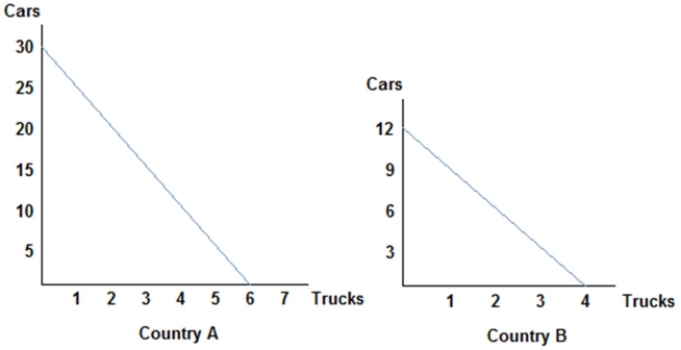 Refer to the figure shown,which represents the production possibilities frontiers for Countries A and B.Considering both country's production possibilities frontiers,we can conclude that Country B will specialize in:
Refer to the figure shown,which represents the production possibilities frontiers for Countries A and B.Considering both country's production possibilities frontiers,we can conclude that Country B will specialize in:
A) trucks,and be willing to accept no fewer than 3 cars for each truck.
B) cars,and be willing to give no more than 3 cars for each truck.
C) trucks,and be willing to accept no more than 3 cars for each truck.
D) cars,and be willing to give no fewer than 3 cars for each truck.
Correct Answer

verified
Correct Answer
verified
Multiple Choice
Choosing to produce at any point within a production possibilities frontier is:
A) inefficient, meaning the society would not be using all its available resources in their best possible uses.
B) efficient, meaning the society would be using all its available resources in their best possible uses.
C) unobtainable, meaning the society cannot produce that combination of goods.
D) efficient but not attainable.
Correct Answer

verified
Correct Answer
verified
Multiple Choice
Suppose that a worker in Country A can make either 10 iPods or 5 tablets each year.Country A has 100 workers.Suppose a worker in Country B can make either 2 iPods or 10 tablets each year.Country B has 200 workers.Suppose Country B's population of workers increased to 600.We can say:
A) Country B now possesses the absolute advantage in the production of both goods.
B) Country B now possesses the absolute advantage in tablets only.
C) Country B now has the comparative advantage in iPod production.
D) Country B has no need to trade now.
Correct Answer

verified
Correct Answer
verified
Multiple Choice
Suppose that a worker in Country A can make either 25 bananas or 5 tomatoes each year.Country A has 200 workers.Suppose a worker in Country B can make either 18 bananas or 6 tomatoes each year.Country B has 400 workers.Suppose Country A specializes in bananas,and Country B specializes in tomatoes.The limits to the terms of trade that Country A would find acceptable are Country A will give no:
A) more than 5 bananas for each tomato.
B) less than 5 bananas for each tomato.
C) more than 1 tomato for every 5 bananas.
D) less than 1 tomato for every 5 bananas.
Correct Answer

verified
Correct Answer
verified
Multiple Choice
Suppose an American worker can make 100 chairs or catch 900 fish per day.On the other hand,a Chilean worker,can make 40 chairs or catch 400 fish per day.The United States has an absolute advantage in the production of both fish and chairs.This means that the United States:
A) should produce only chairs and trade with Chile to get fish.
B) should produce only fish and trade with Chile to get chairs.
C) should take advantage of Chile by trading with them.
D) can produce more fish and chairs than Chile given the same amount of workers.
Correct Answer

verified
Correct Answer
verified
Multiple Choice
Suppose that a worker in Country A can make either 10 iPods or 5 tablets each year.Country A has 100 workers.Suppose a worker in Country B can make either 2 iPods or 10 tablets each year.Country B has 200 workers.Suppose Country B's population of workers increased to 600.Which of the following statements is now true?
A) Country B's production possibilities curve has rotated out for only production of iPods.
B) Country B's production possibilities curve has shifted straight out.
C) Country B's production possibilities curve has shifted straight in.
D) Country B's production possibilities are now more limited because of crowding from having more workers.
Correct Answer

verified
Correct Answer
verified
Showing 1 - 20 of 139
Related Exams